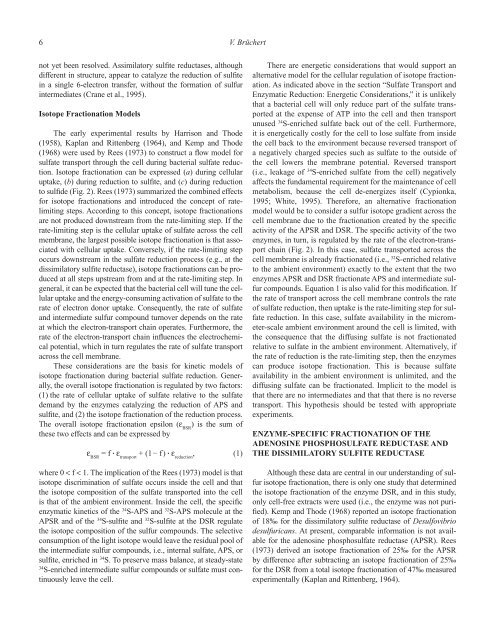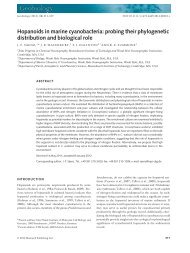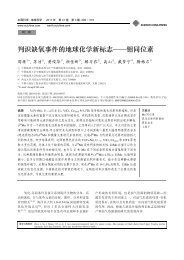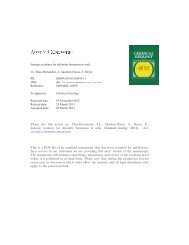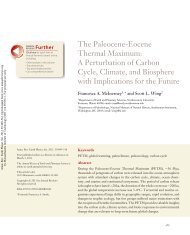Physiological <strong>and</strong> ecological aspects of sulfur isotope fractionation 5Figure 2. Schematic dissimilatory sulfatereduction with hydrogen as electron donor.ATPase—adenosine triphosphatesynthase; NiFeH 2ase—periplasmic nickeliron hydrogenase; APSR—adenosinephosphosulfate reductase; DSR—dissimilatorysulfite reductase; Cyt.C—transmembrane electron carrier CytochromeC; FAD—flavin adenine dinucleotide;FAD-oxidized, FAD-reduced—APSR residue flavin in oxidized <strong>and</strong> reducedform. Sulfate enters the cell togetherwith Na + <strong>and</strong> H + along the crossmembraneion concentration gradient. Atthe ATP sulfurylase, ATP is cleaved torelease 2 P i, <strong>and</strong> the formed adenosinemonophosphate (AMP) reacts with sulfateto form adenosine phosphosulfate(APS). APS reduction occurs at a residueof the APSR, the reduced FAD. An adductof FADH 2sulfite is formed, whichdissociates to oxidized FAD, protons,<strong>and</strong> releases sulfite. The enzymatic reductionof sulfite is described using thetrithionate pathway, which is characterizedby three 2-electron transfer steps.Trithionate dissociates to sulfite <strong>and</strong> thiosulfate,which also dissociates to sulfite<strong>and</strong> hydrogen sulfide. An alternativepathway is a single 6-electron transfer, inwhich no intermediates accumulate. Notethe close spatial coupling between theelectron carrier chain <strong>and</strong> the enzymesparticipating in sulfur compound reduction.The rate of the periplasmic hydrogenasecontrols the rate of electron donor<strong>and</strong> consequently, the rate of the electronacceptor flow.product of this reaction (Fig. 2). This energy-consuming processconsumes one mol ATP per mol sulfate (Cypionka, 1995). Athigh concentrations of APS <strong>and</strong> pyrophosphate, this step wouldbe reversible. To pull the reaction toward APS, PP iis hydrolyzedto phosphate (2 P i), <strong>and</strong> concentrations of APS need to be lessthan 0.1 µM (Rabus et al., 2000), which can only be accomplishedthrough further reduction. Although theoretically possible,the reverse reaction of APS back to sulfate is therefore alsounlikely. Sulfate transport across the membrane <strong>and</strong> activationhave been assumed, but not demonstrated, to occur without anysignificant fractionation.In the third step, the APS complex is reduced by a cytoplasmicAPS reductase to sulfite, which is further reduced to sulfide by thecytoplasmic enzyme dissimilatory sulfite reductase (DSR) (fourthstep). The end product, hydrogen sulfide, is finally transportedout of the cell. Since both reduction steps yield ATP, previouslyinvested ATP for sulfate transport <strong>and</strong> the formation of APS canbe regained (Rabus et al., 2000) (Fig. 2). The breaking of sulfuroxygenbonds in the reduction of APS to sulfite <strong>and</strong> the subsequentreduction to hydrogen sulfide will require different activation energiesfor the molecules with the light <strong>and</strong> heavy isotope, respectively.The molecule with the lighter isotope requires less activationenergy, is reduced faster, <strong>and</strong> is preferentially consumed.Since a large intracellular pool of APS is consideredunlikely, the isotope effect during APS reduction must be small.Larger isotope fractionations may occur at the dissimilatory sulfitereductase. Modulation of the isotope fractionation is possibleif the reduction of sulfite proceeds via the trithionate pathway(Rabus et al., 2000). This pathway is outlined in Figure 2. In thetrithionate pathway of sulfite reduction, reduction takes place inthree 2-electron reductions. Sulfite is reduced to trithionate, whichis reduced to sulfite <strong>and</strong> thiosulfate. Thiosulfate is subsequentlyreduced by a thiosulfate reductase to hydrogen sulfide. While theexistence of recycled sulfite would provide an attractive agentfor regulating isotope fractionation in a mechanism similar todisproportionation (Canfield <strong>and</strong> Thamdrup, 1994), this issue has
6 V. Brüchertnot yet been resolved. Assimilatory sulfite reductases, althoughdifferent in structure, appear to catalyze the reduction of sulfitein a single 6-electron transfer, without the formation of sulfurintermediates (Crane et al., 1995).Isotope Fractionation ModelsThe early experimental results by Harrison <strong>and</strong> Thode(1958), Kaplan <strong>and</strong> Rittenberg (1964), <strong>and</strong> Kemp <strong>and</strong> Thode(1968) were used by Rees (1973) to construct a flow model forsulfate transport through the cell during bacterial sulfate reduction.Isotope fractionation can be expressed (a) during cellularuptake, (b) during reduction to sulfite, <strong>and</strong> (c) during reductionto sulfide (Fig. 2). Rees (1973) summarized the combined effectsfor isotope fractionations <strong>and</strong> introduced the concept of ratelimitingsteps. According to this concept, isotope fractionationsare not produced downstream from the rate-limiting step. If therate-limiting step is the cellular uptake of sulfate across the cellmembrane, the largest possible isotope fractionation is that associatedwith cellular uptake. Conversely, if the rate-limiting stepoccurs downstream in the sulfate reduction process (e.g., at thedissimilatory sulfite reductase), isotope fractionations can be producedat all steps upstream from <strong>and</strong> at the rate-limiting step. Ingeneral, it can be expected that the bacterial cell will tune the cellularuptake <strong>and</strong> the energy-consuming activation of sulfate to therate of electron donor uptake. Consequently, the rate of sulfate<strong>and</strong> intermediate sulfur compound turnover depends on the rateat which the electron-transport chain operates. Furthermore, therate of the electron-transport chain influences the electrochemicalpotential, which in turn regulates the rate of sulfate transportacross the cell membrane.These considerations are the basis for kinetic models ofisotope fractionation during bacterial sulfate reduction. Generally,the overall isotope fractionation is regulated by two factors:(1) the rate of cellular uptake of sulfate relative to the sulfatedem<strong>and</strong> by the enzymes catalyzing the reduction of APS <strong>and</strong>sulfite, <strong>and</strong> (2) the isotope fractionation of the reduction process.The overall isotope fractionation epsilon (ε BSR) is the sum ofthese two effects <strong>and</strong> can be expressed byε BSR= f • ε transport+ (1− f) • ε reduction, (1)where 0 < f < 1. The implication of the Rees (1973) model is thatisotope discrimination of sulfate occurs inside the cell <strong>and</strong> thatthe isotope composition of the sulfate transported into the cellis that of the ambient environment. Inside the cell, the specificenzymatic kinetics of the 34 S-APS <strong>and</strong> 32 S-APS molecule at theAPSR <strong>and</strong> of the 34 S-sulfite <strong>and</strong> 32 S-sulfite at the DSR regulatethe isotope composition of the sulfur compounds. The selectiveconsumption of the light isotope would leave the residual pool ofthe intermediate sulfur compounds, i.e., internal sulfate, APS, orsulfite, enriched in 34 S. To preserve mass balance, at steady-state34S-enriched intermediate sulfur compounds or sulfate must continuouslyleave the cell.There are energetic considerations that would support analternative model for the cellular regulation of isotope fractionation.As indicated above in the section “Sulfate Transport <strong>and</strong>Enzymatic Reduction: Energetic Considerations,” it is unlikelythat a bacterial cell will only reduce part of the sulfate transportedat the expense of ATP into the cell <strong>and</strong> then transportunused 34 S-enriched sulfate back out of the cell. Furthermore,it is energetically costly for the cell to lose sulfate from insidethe cell back to the environment because reversed transport ofa negatively charged species such as sulfate to the outside ofthe cell lowers the membrane potential. Reversed transport(i.e., leakage of 34 S-enriched sulfate from the cell) negativelyaffects the fundamental requirement for the maintenance of cellmetabolism, because the cell de-energizes itself (Cypionka,1995; White, 1995). Therefore, an alternative fractionationmodel would be to consider a sulfur isotope gradient across thecell membrane due to the fractionation created by the specificactivity of the APSR <strong>and</strong> DSR. The specific activity of the twoenzymes, in turn, is regulated by the rate of the electron-transportchain (Fig. 2). In this case, sulfate transported across thecell membrane is already fractionated (i.e., 32 S-enriched relativeto the ambient environment) exactly to the extent that the twoenzymes APSR <strong>and</strong> DSR fractionate APS <strong>and</strong> intermediate sulfurcompounds. Equation 1 is also valid for this modification. Ifthe rate of transport across the cell membrane controls the rateof sulfate reduction, then uptake is the rate-limiting step for sulfatereduction. In this case, sulfate availability in the micrometer-scaleambient environment around the cell is limited, withthe consequence that the diffusing sulfate is not fractionatedrelative to sulfate in the ambient environment. Alternatively, ifthe rate of reduction is the rate-limiting step, then the enzymescan produce isotope fractionation. This is because sulfateavailability in the ambient environment is unlimited, <strong>and</strong> thediffusing sulfate can be fractionated. Implicit to the model isthat there are no intermediates <strong>and</strong> that that there is no reversetransport. This hypothesis should be tested with appropriateexperiments.ENZYME-SPECIFIC FRACTIONATION OF THEADENOSINE PHOSPHOSULFATE REDUCTASE ANDTHE DISSIMILATORY SULFITE REDUCTASEAlthough these data are central in our underst<strong>and</strong>ing of sulfurisotope fractionation, there is only one study that determinedthe isotope fractionation of the enzyme DSR, <strong>and</strong> in this study,only cell-free extracts were used (i.e., the enzyme was not purified).Kemp <strong>and</strong> Thode (1968) reported an isotope fractionationof 18‰ for the dissimilatory sulfite reductase of Desulfovibriodesulfuricans. At present, comparable information is not availablefor the adenosine phosphosulfate reductase (APSR). Rees(1973) derived an isotope fractionation of 25‰ for the APSRby difference after subtracting an isotope fractionation of 25‰for the DSR from a total isotope fractionation of 47‰ measuredexperimentally (Kaplan <strong>and</strong> Rittenberg, 1964).
- Page 2: Sulfur Biogeochemistry—Past and P
- Page 8: Preface viisulfurization on the pre
- Page 11 and 12: 2 V. BrüchertThe resulting sulfur
- Page 13: 4 V. BrüchertFigure 1. Phylogeneti
- Page 17 and 18: 8 V. BrüchertEFFECT OF ELECTRON DO
- Page 19 and 20: 10 V. Brüchertfractionation factor
- Page 21 and 22: 12 V. BrüchertFigure 4. Depth prof
- Page 23 and 24: 14 V. Brüchertto derive isotope fr
- Page 25 and 26: 16 V. BrüchertRudnicki, M.D., Elde
- Page 28 and 29: Microbially mediated sulfur-redox 1
- Page 30 and 31: Microbially mediated sulfur-redox 2
- Page 32 and 33: Microbially mediated sulfur-redox 2
- Page 34 and 35: Microbially mediated sulfur-redox 2
- Page 36 and 37: Microbially mediated sulfur-redox 2
- Page 38 and 39: Microbially mediated sulfur-redox 2
- Page 40 and 41: Microbially mediated sulfur-redox 3
- Page 42 and 43: Microbially mediated sulfur-redox 3
- Page 44 and 45: Geological Society of AmericaSpecia
- Page 46 and 47: Eukaryotes of the Cariaco, Soledad,
- Page 48 and 49: Eukaryotes of the Cariaco, Soledad,
- Page 50 and 51: Eukaryotes of the Cariaco, Soledad,
- Page 52 and 53: Eukaryotes of the Cariaco, Soledad,
- Page 54 and 55: Eukaryotes of the Cariaco, Soledad,
- Page 56: Eukaryotes of the Cariaco, Soledad,
- Page 59 and 60: 50 A. SchippersTABLE 1. DETECTION O
- Page 61 and 62: 52 A. SchippersS 4O 62−+ H 2O →
- Page 63 and 64: 54 A. Schippersthe oxygen molecule
- Page 65 and 66:
56 A. Schippersprohibits biological
- Page 67 and 68:
58 A. SchippersSampleTABLE 4. SULFU
- Page 69 and 70:
60 A. SchippersGeochimica et Cosmoc
- Page 71 and 72:
62 A. SchippersSasaki, K., Tsunekaw
- Page 73 and 74:
64 B.B. Jørgensen and D.C. NelsonI
- Page 75 and 76:
66 B.B. Jørgensen and D.C. NelsonF
- Page 77 and 78:
68 B.B. Jørgensen and D.C. Nelsonq
- Page 79 and 80:
70 B.B. Jørgensen and D.C. Nelsons
- Page 81 and 82:
72 B.B. Jørgensen and D.C. Nelsonp
- Page 83 and 84:
74 B.B. Jørgensen and D.C. NelsonP
- Page 85 and 86:
76 B.B. Jørgensen and D.C. Nelsont
- Page 87 and 88:
78 B.B. Jørgensen and D.C. NelsonF
- Page 89 and 90:
80 B.B. Jørgensen and D.C. NelsonJ
- Page 92 and 93:
Geological Society of AmericaSpecia
- Page 94 and 95:
Formation and degradation of seafl
- Page 96 and 97:
Formation and degradation of seafl
- Page 98 and 99:
Formation and degradation of seafl
- Page 100 and 101:
Formation and degradation of seafl
- Page 102 and 103:
Formation and degradation of seafl
- Page 104 and 105:
Formation and degradation of seafl
- Page 106 and 107:
Geological Society of AmericaSpecia
- Page 108 and 109:
Distribution and fate of sulfur int
- Page 110 and 111:
Distribution and fate of sulfur int
- Page 112 and 113:
Distribution and fate of sulfur int
- Page 114 and 115:
Distribution and fate of sulfur int
- Page 116 and 117:
Distribution and fate of sulfur int
- Page 118 and 119:
Distribution and fate of sulfur int
- Page 120 and 121:
Distribution and fate of sulfur int
- Page 122 and 123:
Distribution and fate of sulfur int
- Page 124 and 125:
Distribution and fate of sulfur int
- Page 126 and 127:
Geological Society of AmericaSpecia
- Page 128 and 129:
- HSO 4SO 2-4H 2 SCO 32-HCO 3-HCO 3
- Page 130 and 131:
Sedimentary pyrite formation 121mar
- Page 132 and 133:
Sedimentary pyrite formation 123The
- Page 134 and 135:
Sedimentary pyrite formation 125Ben
- Page 136 and 137:
Sedimentary pyrite formation 127TAB
- Page 138 and 139:
Sedimentary pyrite formation 129The
- Page 140 and 141:
Sedimentary pyrite formation 131Dek
- Page 142 and 143:
Sedimentary pyrite formation 133Mor
- Page 144 and 145:
Geological Society of AmericaSpecia
- Page 146 and 147:
Recent advances and future research
- Page 148 and 149:
Recent advances and future research
- Page 150 and 151:
Recent advances and future research
- Page 152 and 153:
Recent advances and future research
- Page 154 and 155:
Recent advances and future research
- Page 156 and 157:
Recent advances and future research
- Page 158 and 159:
Recent advances and future research
- Page 160 and 161:
Geological Society of AmericaSpecia
- Page 162 and 163:
Using sulfur isotopes to elucidate
- Page 164 and 165:
Using sulfur isotopes to elucidate
- Page 166 and 167:
Using sulfur isotopes to elucidate
- Page 168 and 169:
Using sulfur isotopes to elucidate
- Page 170 and 171:
Geological Society of AmericaSpecia
- Page 172 and 173:
Sites of anomalous organic reminera
- Page 174 and 175:
Sites of anomalous organic reminera
- Page 176 and 177:
Sites of anomalous organic reminera
- Page 178 and 179:
Sites of anomalous organic reminera
- Page 180 and 181:
Sites of anomalous organic reminera
- Page 182 and 183:
Sites of anomalous organic reminera
- Page 184 and 185:
Sites of anomalous organic reminera
- Page 186 and 187:
Geological Society of AmericaSpecia
- Page 188 and 189:
Sulfur isotope composition of carbo
- Page 190 and 191:
Sulfur isotope composition of carbo
- Page 192 and 193:
Sulfur isotope composition of carbo
- Page 194 and 195:
Sulfur isotope composition of carbo
- Page 196 and 197:
Sulfur isotope composition of carbo
- Page 198 and 199:
Sulfur isotope composition of carbo
- Page 200 and 201:
Sulfur isotope composition of carbo
- Page 202 and 203:
Sulfur isotope composition of carbo
- Page 204 and 205:
Geological Society of AmericaSpecia
- Page 206 and 207:
4 Ga of seawater evolution 197brine
- Page 208 and 209:
4 Ga of seawater evolution 199Figur
- Page 210 and 211:
4 Ga of seawater evolution 201data
- Page 212 and 213:
4 Ga of seawater evolution 203notab
- Page 214:
4 Ga of seawater evolution 205et Co


